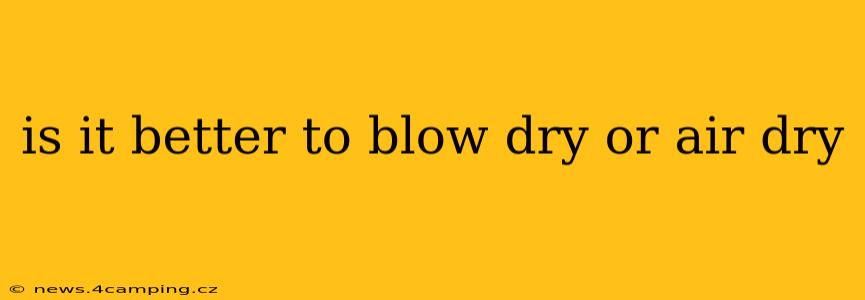The age-old question: air dry or blow dry? The answer, like most things related to hair care, isn't a simple yes or no. The best method depends entirely on your hair type, styling preferences, and the time you have available. Let's delve into the pros and cons of each to help you make the best choice for your gorgeous locks.
What are the benefits of air drying?
Air drying offers several advantages, making it a popular choice for many.
-
Less Heat Damage: This is the biggest draw. Heat styling, even with heat protectant, can cause damage to your hair over time, leading to dryness, breakage, and split ends. Air drying completely eliminates this risk.
-
More Natural Texture: Air drying allows your hair's natural texture to shine through, whether that's straight, wavy, curly, or coily. It can enhance your natural waves or curls, resulting in a softer, more defined look.
-
Often Healthier Hair: The gentler nature of air drying can contribute to healthier, shinier hair in the long run. It minimizes stress on the hair shaft, promoting stronger, less damaged strands.
-
Saves Time (Eventually): While it may seem like air drying takes longer, once you establish a good routine, the time saved in the long run by reducing heat damage and potential styling mishaps can actually be significant.
What are the benefits of blow drying?
Blow drying, despite the potential for damage, also has its merits.
-
Faster Styling: This is the most obvious advantage. Blow drying significantly reduces drying time, especially crucial on busy mornings or when you have a specific style in mind.
-
More Styling Control: A blow dryer offers greater control over your hairstyle. You can create sleek straight looks, voluminous styles, or even defined curls with the right attachments and techniques.
-
Can Add Volume: Used correctly, a blow dryer can add volume and lift to your hair, creating a fuller, bouncier appearance.
Which method is better for different hair types?
The optimal drying method significantly depends on your hair type:
-
Fine Hair: Air drying can sometimes leave fine hair looking limp and flat. Blow drying with a round brush can add volume and lift.
-
Thick Hair: Thick hair takes significantly longer to air dry, making blow drying a more practical option. However, always use a heat protectant.
-
Curly Hair: Many with curly hair prefer air drying to preserve their curls' natural shape and reduce frizz. Blow drying can be used with a diffuser attachment to enhance curls, but too much heat can lead to dryness.
-
Color-Treated Hair: Air drying is generally recommended for color-treated hair to minimize color fading and damage caused by heat.
How can I make air drying easier?
Air drying doesn't have to be a tedious process. Here are a few tips:
-
Use a Leave-In Conditioner: This helps to detangle your hair and adds moisture, making it easier to manage while air drying.
-
Apply a Styling Product: Products like mousse or curl cream can help to define your curls or waves and prevent frizz.
-
Use a Microfiber Towel or T-Shirt: These absorb water more gently than a regular towel, minimizing friction and preventing damage.
-
Consider a Hair Drying Cap: A hair drying cap or bonnet can help speed up the drying process while still being gentler than a blow dryer.
What are the risks of blow drying my hair too much?
Overuse of a blow dryer can significantly damage your hair, causing:
- Dryness and brittleness: Heat strips away moisture, leading to dry, brittle, and easily breakable hair.
- Split ends: Frequent heat styling can cause split ends to form, making your hair look frizzy and unhealthy.
- Hair breakage: Repeated exposure to heat can weaken your hair shaft, making it more prone to breakage.
Does using a heat protectant make a difference?
Yes! A heat protectant is crucial if you regularly blow dry your hair. It forms a barrier between your hair and the heat, minimizing damage. However, it's still advisable to limit the heat and drying time as much as possible.
In conclusion, the "better" method depends entirely on your individual needs and hair type. Prioritizing hair health means understanding your hair and choosing the method that best supports its health and your desired style. Experiment to find what works best for you!
